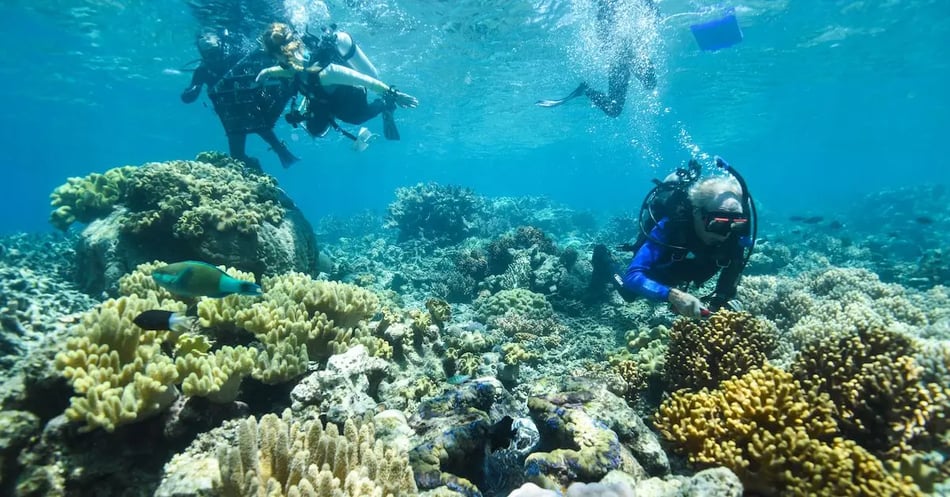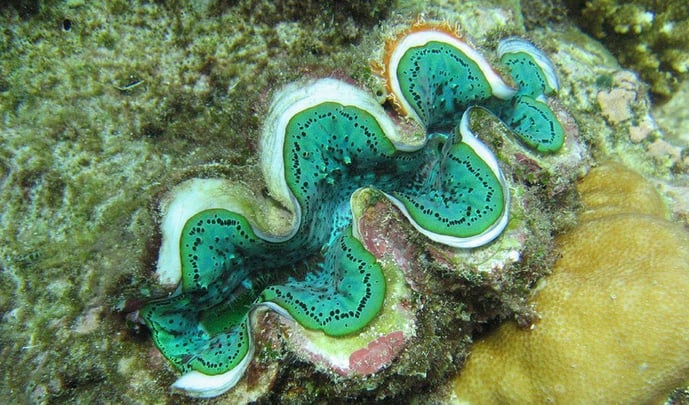The importance of reef restoration - and how giant clams can help

Jordan
4
min. read

At IMARCS there is a focus on carbon sequestration; after all, it is what the last two letters in the acronym represent. But in addition to exploring the possibility of using giant clams for marine-based carbon dioxide removal, known as mCDR, growing these clams via mariculture could also have a positive impact on reef biodiversity. Re-introducing giant clams into reef ecosystems, after being moved from in-shore tank facilities, should result in a range of positive effects as their large size and filter-feeding abilities can serve a vital role. This would occur through the provision of several additions, including habitat structures created by shells, improved water quality from giant clam filtration, and perhaps more regulated algal and invertebrate distribution.
There have been several small-scale efforts to reintroduce giant clams within reefs, including some projects in Australia and the Philippines. These provided good insight into the potential for increasing biodiversity and restoring ecological balance within degraded reef systems. However, there have been no large-scale projects to determine more conclusively the effects of giant clam re-introduction - and while there is ample literature available on giant clams and how they contribute to biodiversity within ecosystems, there remains little available data on the impacts of re-introducing these organisms into reef environments.
We are currently pioneering research at IMARCS that will culminate in a project that reintroduces five different species of giant clams in strategically chosen reef locations for the express purpose of studying the impacts on biodiversity. Continued research in this area holds promise not only for reef ecosystem restoration and sustainable management of giant clam populations, but also could serve a potential role in sequestering atmospheric CO2, which is in line with our mission and vision.
Why are marine reefs important?
Coral reefs are understandably important for life underwater, but they are also, by extension, important for life on land. Reefs provide an ideal habitat for a large variety of marine life, including various sponges, oysters, clams, crabs, sea stars, sea urchins, and many species of fish; they are also ecologically linked to seagrass, mangrove, and mudflat communities that are often nearby.
Marine reefs are also important for fostering and nurturing biodiversity, as they are among the most biodiverse ecosystems on the planet: they support approximately one-quarter of all marine life, despite covering less than 1% of the ocean floor. Furthermore, reefs serve as nurseries and feeding grounds for many commercially important fish species which are vital for human (and animal) food security and livelihoods for millions of people around the world. Lastly, reefs protect the planet by acting as natural buffers for coastlines, reducing the impacts of storms, waves, and erosion - and they are important carbon sinks, sequestering carbon dioxide from the atmosphere and helping to mitigate or at least slow climate change.
If all of these reasons were not enough, there is also one other thing that makes them important to human beings: they are pretty. Coral reefs are among the most beautiful natural features in the world, and they draw countless tourists and tourism dollars every year.
Marine reefs are also important for fostering and nurturing biodiversity, as they are among the most biodiverse ecosystems on the planet: they support approximately one-quarter of all marine life, despite covering less than 1% of the ocean floor. Furthermore, reefs serve as nurseries and feeding grounds for many commercially important fish species which are vital for human (and animal) food security and livelihoods for millions of people around the world. Lastly, reefs protect the planet by acting as natural buffers for coastlines, reducing the impacts of storms, waves, and erosion - and they are important carbon sinks, sequestering carbon dioxide from the atmosphere and helping to mitigate or at least slow climate change.
If all of these reasons were not enough, there is also one other thing that makes them important to human beings: they are pretty. Coral reefs are among the most beautiful natural features in the world, and they draw countless tourists and tourism dollars every year.

Image Credits - https://blog.education.nationalgeographic.org/2015/10/09/coral-bleaching-crisis/
Major causes of reef degradation
There are several major causes of reef degradation, mainly from the following:
Climate Change
Corals are extremely sensitive animals; even the slightest rise in temperature can cause coral bleaching, where corals expel the algae living in their tissues, turning them white and making them more susceptible to disease.
Ocean Acidification
Increased levels of carbon dioxide in the atmosphere lead to increased dissolution of this gas in the oceans, which directly causes acidification (which, in turn, reduces the ability of corals and giant clams to build their calcium carbonate skeletons and shells).
Increased levels of carbon dioxide in the atmosphere lead to increased dissolution of this gas in the oceans, which directly causes acidification (which, in turn, reduces the ability of corals and giant clams to build their calcium carbonate skeletons and shells).
Pollution
Runoff from agricultural activities, sewage discharge, and pollution from industrial sources introduce harmful chemicals and nutrients into reef ecosystems, leading to algal blooms that reduce water quality and effectively smother the algae that produce the necessary nourishment for corals and giant clams.
Overfishing and Overharvesting
Overfishing disrupts the delicate balance of reef ecosystems by removing key species that help maintain the health of the reef, such as herbivorous fish that control algae growth. This has also been the main driver of giant clam endangerment in most areas - and extinction in certain areas where they once thrived.
Overfishing disrupts the delicate balance of reef ecosystems by removing key species that help maintain the health of the reef, such as herbivorous fish that control algae growth. This has also been the main driver of giant clam endangerment in most areas - and extinction in certain areas where they once thrived.
Destructive Fishing Practices
Practices like blast fishing, cyanide fishing, and bottom trawling can directly damage coral reefs.
Coastal Development
Coastal development, including dredging, construction, and tourism infrastructure, can lead to habitat destruction, sedimentation, and increased pollution, all of which harm reef ecosystems.
Coastal development, including dredging, construction, and tourism infrastructure, can lead to habitat destruction, sedimentation, and increased pollution, all of which harm reef ecosystems.
Invasive Species
Introduction of invasive species, either intentionally or accidentally, can disrupt reef ecosystems by outcompeting native species for resources or directly preying on coral organisms.
Benefits of reef restoration
Reef restoration preserves the qualities that make reefs important, as listed above, as well as:
- Enhances biodiversity preservation
- Enhances fisheries potential
- Enhances coastal protection
- Affords greater carbon sequestration
- Leads to cultural restoration
- Restores spiritual significance
- Creates research and education opportunities
Specific benefits associated with giant clam re-introduction
The re-introduction of giant clams will help to restore reef ecosystems in a way that is uniquely beneficial. These benefits include:
- Water filtration
- Varied habitat provision
- Greater micro-biodiversity
- Microplastic capture
- Enhanced reef vibrancy and beauty
The exceptional filtering capabilities of giant clams enahnces water quality by removing particulate matter, excess nutrients, and even microplastics from the water column; it also reduces turbidity and nutrient levels, benefiting various organisms that rely on clear, nutrient-balanced water. Greater numbers of giant clams in reefs promotes coral and beneficial algal growth through improved water clarity, which allows more sunlight penetration. This ultimately leads to greater biodiversity and better overall health within reefs. Giant clams also directly contribute to increased biodiversity by providing more diverse habitats and protective structures, compared to corals or anemones, for various organisms.
And last but not least: they make the reef even more pretty, as they are among the most beautiful organisms in the world, even among a backdrop already as stunning and vibrant as a thriving coral reef.
And last but not least: they make the reef even more pretty, as they are among the most beautiful organisms in the world, even among a backdrop already as stunning and vibrant as a thriving coral reef.

Image Credits - https://www.australiangeographic.com.au/topics/science-environment/2017/09/the-oceans-giant-clams/
Sources:
Featured Image Credits - SOURCE: REEF RESTORATION FOUNDATION
Artificial Reefs Program | Boskalis. (n.d.). Royal Boskalis Westminster NV. https://boskalis.com/artificialreefs
National Marine Sanctuary, F. K. (n.d.). Thunderbolt. Thunderbolt. https://floridakeys.noaa.gov/shipwrecktrail/thunderbolt.html
New Haven Reef Conservation. (n.d.). Artificial Reefs: What works and what doesn’t. Artificial Reefs: What Works and What Doesn’t. https://newheavenreefconservation.org/marine-blog/147-artificial-reefs-what-works-and-what-doesn-t
Purpose of reefs. (n.d.). EcoShape - EN. https://www.ecoshape.org/en/knowledge-articles/artificial-reefs/purpose-of-reefs/
What is an artificial reef? (n.d.). What Is an Artificial Reef? https://oceanservice.noaa.gov/facts/artificial-reef.html